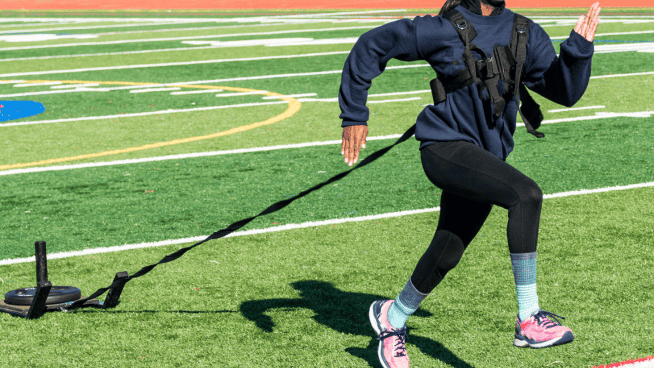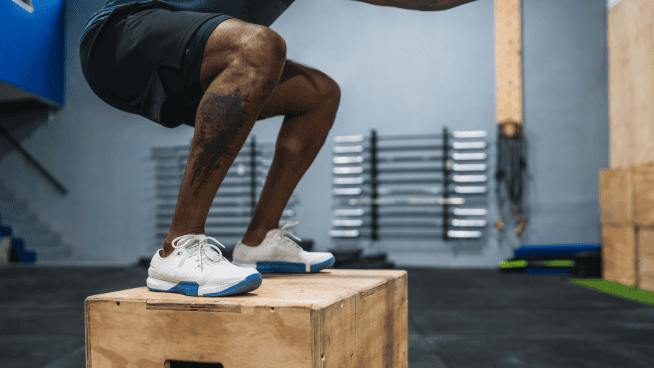3 Tricks for a Stronger Front Squat
![]()
Squatting is simple, right? Grab the weight, sit down, stand up. BOOM—massive gains in strength and size, right?
Hold on. Squatting is simple, but not easy, as anyone who’s ever tried to Front Squat knows.
But don’t give up so easily, especially on an exercise that has potential to make you stronger, faster, more powerful and more mobile. If you learn to fix one simple problem, you’ll see your squat strength go through the roof. Check out the video player above for a demonstration.
The Problem: Falling Forward
The biggest Front Squat mistake is dropping the elbows, which causes you to lean forward as you stand up. Unlike a Back Squat, where you can support the weight across the back of your shoulders, this exercise requires you to hold the weight in front (hence the painfully obvious exercise name), shifting the weight of the bar forward of your hips, making it harder to stay tall as you squat down.
But no matter how much you think “elbows up,” it won’t make one bit of difference if your setup isn’t spot-on. To avoid falling forward (which increases the risk of injury from dropping the bar or straining your back), watch the above video and try these three Front Squat setup tricks.
1. Get the Bar in the Right Position
Many people simply don’t know where to put the bar on their shoulders. If the bar is too far toward your hands, it will roll forward and your elbows will drop. And if the bar is too far back toward your throat, you’ll have a hard time taking a deep breath and getting tight. To make sure the bar position is just right, try this:
- Hold your arms out straight at chest height with your thumbs pointed up.
- Stand under an empty bar in the squat rack so the bar rests across your shoulders just in front of your Adam’s apple.
- Still holding your arms straight, stand up to unrack the bar. If the bar balances easily without rolling forward, you’ve found a good rack position.
- Re-rack the bar, assume a clean or cross-face grip, and do your set of Squats as normal.
2. Learn How to Get Air into Your Belly and Back
Unfortunately, when most people try to stay tall and get their elbows up during the Front Squat, they arch their back and flair their ribcage. This actually puts them in a worse position, because it makes it almost impossible to get a good breath of air into the abdomen. And without a big breath to stabilize the spine, you’ll be more likely to lean forward under heavy weight.
Instead, learn to bring the ribs down by exhaling before you unrack the bar. Try this:
- Get under the bar as described in Step 1.
- Before unracking the bar, exhale fully (as if you were blowing up a balloon) to bring your ribs down. Slightly “crunch” your abs, squeeze your glutes and roll your belt buckle up toward your chin.
- Lock in this position and take a big breath of air into your belly and back. Take in as much air as possible (try having a coach or training partner put their hands on your stomach and/or back, and push air into their hands.)
- Unrack the bar and Squat without losing your rib position or breath.
- Repeat the exhale/inhale cycle for each rep.
3. Sit Down, Not Back
Many people learn to Squat by sitting back, not down. This is great because it teaches people to use their hips, glutes and hamstrings while squatting and prevents the knees from shooting too far forward over the toes. However, it also causes you to lean forward quite a bit, which is fine during the Back Squat, but if you sit back during the Front Squat, you’ll drop your elbows and risk dropping the bar.
Instead of sitting back, learn to sit down directly between your knees by doing this:
- After unracking the bar, screw your feet into the ground. Imagine trying to spin a dinner plate clockwise with your right foot and counterclockwise with your left foot.
- To begin squatting down, drive your knees out as if you were trying to spread the floor apart.
- Once your knees are out, sit straight down between your knees while keeping your chest tall.
- Continue to “spread the floor” until you reach the bottom, then drive through your heels to stand back up.
Front Squats Are Your Friend
Once you master the technique, Front Squats will unlock new levels of strength, speed and power. Don’t be afraid of falling forward. Just use these tips to stand tall and squat heavy.
RECOMMENDED FOR YOU
MOST POPULAR
3 Tricks for a Stronger Front Squat
![]()
Squatting is simple, right? Grab the weight, sit down, stand up. BOOM—massive gains in strength and size, right?
Hold on. Squatting is simple, but not easy, as anyone who’s ever tried to Front Squat knows.
But don’t give up so easily, especially on an exercise that has potential to make you stronger, faster, more powerful and more mobile. If you learn to fix one simple problem, you’ll see your squat strength go through the roof. Check out the video player above for a demonstration.
The Problem: Falling Forward
The biggest Front Squat mistake is dropping the elbows, which causes you to lean forward as you stand up. Unlike a Back Squat, where you can support the weight across the back of your shoulders, this exercise requires you to hold the weight in front (hence the painfully obvious exercise name), shifting the weight of the bar forward of your hips, making it harder to stay tall as you squat down.
But no matter how much you think “elbows up,” it won’t make one bit of difference if your setup isn’t spot-on. To avoid falling forward (which increases the risk of injury from dropping the bar or straining your back), watch the above video and try these three Front Squat setup tricks.
1. Get the Bar in the Right Position
Many people simply don’t know where to put the bar on their shoulders. If the bar is too far toward your hands, it will roll forward and your elbows will drop. And if the bar is too far back toward your throat, you’ll have a hard time taking a deep breath and getting tight. To make sure the bar position is just right, try this:
- Hold your arms out straight at chest height with your thumbs pointed up.
- Stand under an empty bar in the squat rack so the bar rests across your shoulders just in front of your Adam’s apple.
- Still holding your arms straight, stand up to unrack the bar. If the bar balances easily without rolling forward, you’ve found a good rack position.
- Re-rack the bar, assume a clean or cross-face grip, and do your set of Squats as normal.
2. Learn How to Get Air into Your Belly and Back
Unfortunately, when most people try to stay tall and get their elbows up during the Front Squat, they arch their back and flair their ribcage. This actually puts them in a worse position, because it makes it almost impossible to get a good breath of air into the abdomen. And without a big breath to stabilize the spine, you’ll be more likely to lean forward under heavy weight.
Instead, learn to bring the ribs down by exhaling before you unrack the bar. Try this:
- Get under the bar as described in Step 1.
- Before unracking the bar, exhale fully (as if you were blowing up a balloon) to bring your ribs down. Slightly “crunch” your abs, squeeze your glutes and roll your belt buckle up toward your chin.
- Lock in this position and take a big breath of air into your belly and back. Take in as much air as possible (try having a coach or training partner put their hands on your stomach and/or back, and push air into their hands.)
- Unrack the bar and Squat without losing your rib position or breath.
- Repeat the exhale/inhale cycle for each rep.
3. Sit Down, Not Back
Many people learn to Squat by sitting back, not down. This is great because it teaches people to use their hips, glutes and hamstrings while squatting and prevents the knees from shooting too far forward over the toes. However, it also causes you to lean forward quite a bit, which is fine during the Back Squat, but if you sit back during the Front Squat, you’ll drop your elbows and risk dropping the bar.
Instead of sitting back, learn to sit down directly between your knees by doing this:
- After unracking the bar, screw your feet into the ground. Imagine trying to spin a dinner plate clockwise with your right foot and counterclockwise with your left foot.
- To begin squatting down, drive your knees out as if you were trying to spread the floor apart.
- Once your knees are out, sit straight down between your knees while keeping your chest tall.
- Continue to “spread the floor” until you reach the bottom, then drive through your heels to stand back up.
Front Squats Are Your Friend
Once you master the technique, Front Squats will unlock new levels of strength, speed and power. Don’t be afraid of falling forward. Just use these tips to stand tall and squat heavy.
[cf]skyword_tracking_tag[/cf]









